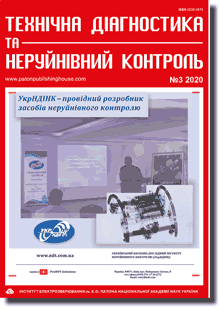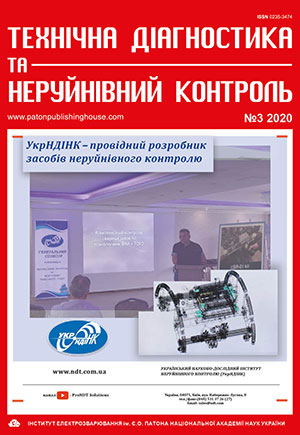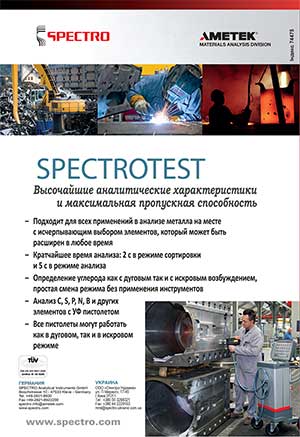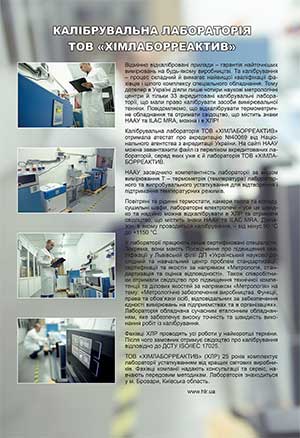| 2020 №03 (02) |
DOI of Article 10.37434/tdnk2020.03.03 |
2020 №03 (04) |

Technical Diagnostics and Non-Destructive Testing #3, 2020, pp. 23-29
Fracture resistance and damageability of linear-elastic ceramics under the conditions of edge local loading: a statistical analysis
V.V. Khvorostianyi, Y.M. Rodichev, O.B. Soroka
G.S. Pisarenko Institute for Problems of Strength of NAS of Ukraine. 2 Timiryazevska Str, 01014, Kiyv, Ukraine. E-mail: khvorostianyi.v.v@ipp.kiev.ua
A statistical analysis of experimental data of linear-elastic single-phase ceramics, tested under local loading by scratching of specimen surface up to the edge chipping by the Rockwell indenter, was performed. Experimental dependences of Weibull distribution for the parameters of damageability and fracture resistance of the edge were constructed and monomodal approximations were applied. The diagrams of fracture of ceramic materials are obtained taking into account the data of statistical analysis, which refect the patterns of change in the value of the edge damageability parameter at diferent values of fracture probability. A comparison of experimental and calculated statistical results was given. It is concluded that the combination of empirical and analytical data on the damageability of the edges and their resistance to fracture under the indicated test conditions makes it possible to obtain reasonable values of the corresponding parameters, which are necessary for further reliable prediction of the performance of ceramics. The proposed approach significantly increases the accuracy of estimation of the used parameters of mechanical behavior of brittle materials and contributes to rational selection of optimal operating conditions for them. 20 Ref, 2 Tabl. 2, 5 Fig.
Keywords: ceramics, scratching up to edge chipping, damageability and fracture resistance parameters, diagrams of fracture, Weibull distribution, statistical estimation and prediction
Received: 06.08.2020
References
1. McCormick, N.J., Almond, E.A. (1990) Edge faking of brittle materials. J. Hard Mater., 1, 25-51.2. Scieszka, S.F. (2005) Edge failure as a means of concurrently estimating the abrasion and edge fracture resistance of hard-metals. Tribology Int., 38, 834-842. https://doi.org/10.1016/j.triboint.2005.02.011
3. Gogotsi, G.A., Galenko, V.I., Mudrik, S.P. et al. (2010) Fracture resistance estimation of elastic ceramics in edge faking: EF baseline. J. Eur. Ceram. Soc., 30, 1223-1228. https://doi.org/10.1016/j.jeurceramsoc.2009.12.002
4. Khvorostianyi, V.V. (2014) Mechanical behaviour of ceramics and glass at local fractures of sample edges by Rockwell indenter. Problemy Prochnosti, 3, 106-115. https://doi.org/10.1007/s11223-014-9560-8
5. Quinn G.D. (2015) On edge chipping testing and some personal perspectives on the state of the art of mechanical testing. Dental Materials, 31, 26-36. https://doi.org/10.1016/j.dental.2014.08.378
6. Jayatilaka, ADeS., Trustrum, K. (1977) Statistical approach to brittle fracture. J. Mater. Sci., 12, 1426-1430. https://doi.org/10.1007/BF00540858
7. Khvorostianyi, V.V. (2010) Determination of fracture resistance of ceramics at S+EF method (scratching of sample surface up to edge chipping). In: Abstr. of Papers of 11th Int. Conf. on Advanced Engineering and Technology - 2020 (Kyiv, 18-21 May, 2010).
8. (2010) Advanced technical ceramics - Mechanical properties of monolithic ceramics at room temperature. Pt 9: Method of test for edge-chip resistance. CEN/TS 834-9. [Current from 2010-08-15]. CEN, 2010, European Standard.
9. Quinn, J., Su, L., Flanders, L., Lloyd, I. (2000) «Edge toughness» and material properties related to the machining of dental ceramics. Machining Sci. and Technology, 291-304. https://doi.org/10.1080/10940340008945711
10. Petit, F., Vandeneede, V., Cambier, F. (2009) Ceramic toughness assessment through edge chipping measurements - Infuence of interfacial friction. J. Eur. Ceram. Soc., 29, 2135- 2141. https://doi.org/10.1016/j.jeurceramsoc.2009.01.019
11. Gogotsi, G.A., Galenko, V.I., Mudrik, S.P. et al. (2007) Glass fracture at edge chipping. Problemy Prochnosti, 6, 103-112 [in Russian].
12. Williams, J.A. (1996) Analytical models of scratch hardness. Tribology Int., 29, 675-694. https://doi.org/10.1016/0301-679X(96)00014-X
13. Flanders, L.A., Quinn, J.B., Wilson, Jr. O.C., Lloyd, I.K. (2003) Scratch hardness and chipping of dental ceramics under different environments. Dental Materials, 19, 716-724. https://doi.org/10.1016/S0109-5641(03)00018-6
14. Chai, H., Lawn, B.R. (2007) A universal relation for edge chipping from sharp contacts in brittle materials: A simple means of toughness evaluation. Acta Materialia, 55, 2555- 2561. https://doi.org/10.1016/j.actamat.2006.10.061
15. Morrell, R., Gant, A.J. (2001) Edge chipping of hard metals. Int. J. Refract. Met. & Hard Mater., 19, 293 - 301. https://doi.org/10.1016/S0263-4368(01)00030-0
16. Weibull,W. (1939) A statistical theory of the strength of materials. Proc. Royal Swedish Inst. Eng. Res., 151, 1-45.
17. (2003) Fine ceramics (advanced ceramics, advanced technical ceramics) - Weibull statistics for strength data. ISO 20501:2003 Ed 1 (R09). [Current from 2003-12-01]. ISO/TC 206, 2003. Int. Standard.
18. Quinn, J.B., Quinn, G.D. (2010) A practical and systematic review of Weibull statistics for reporting strengths of dental materials. Dental Materials, 26, 135-147. https://doi.org/10.1016/j.dental.2009.09.006
19. Tikhov, M.S., Ageev, V.V., Borodina, T.S. (2010) Evaluation of Weibull distribution parameters. Vestnik Nizhegorod. Unta N.I. Lobachevskogo, 4, 141-145 [in Russian].
20. Rodichev, Yu.M., Soroka, E.B., Shabetya, A.A. et al. Evaluation of local strength and damageability of brittle materials by the parameters of statistical distribution of experimental data. Visnyk Ternopil. Nats. Un-tu, 4, 161-173 [in Russian].




